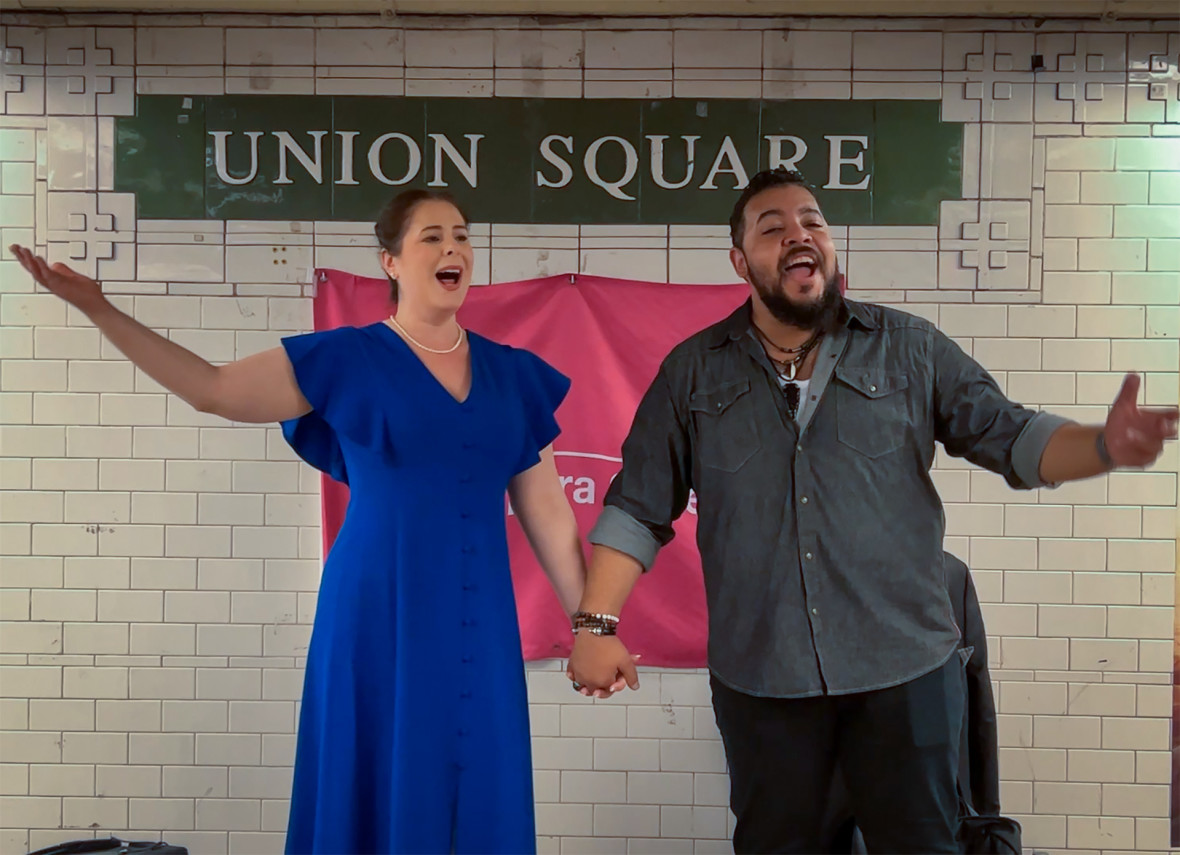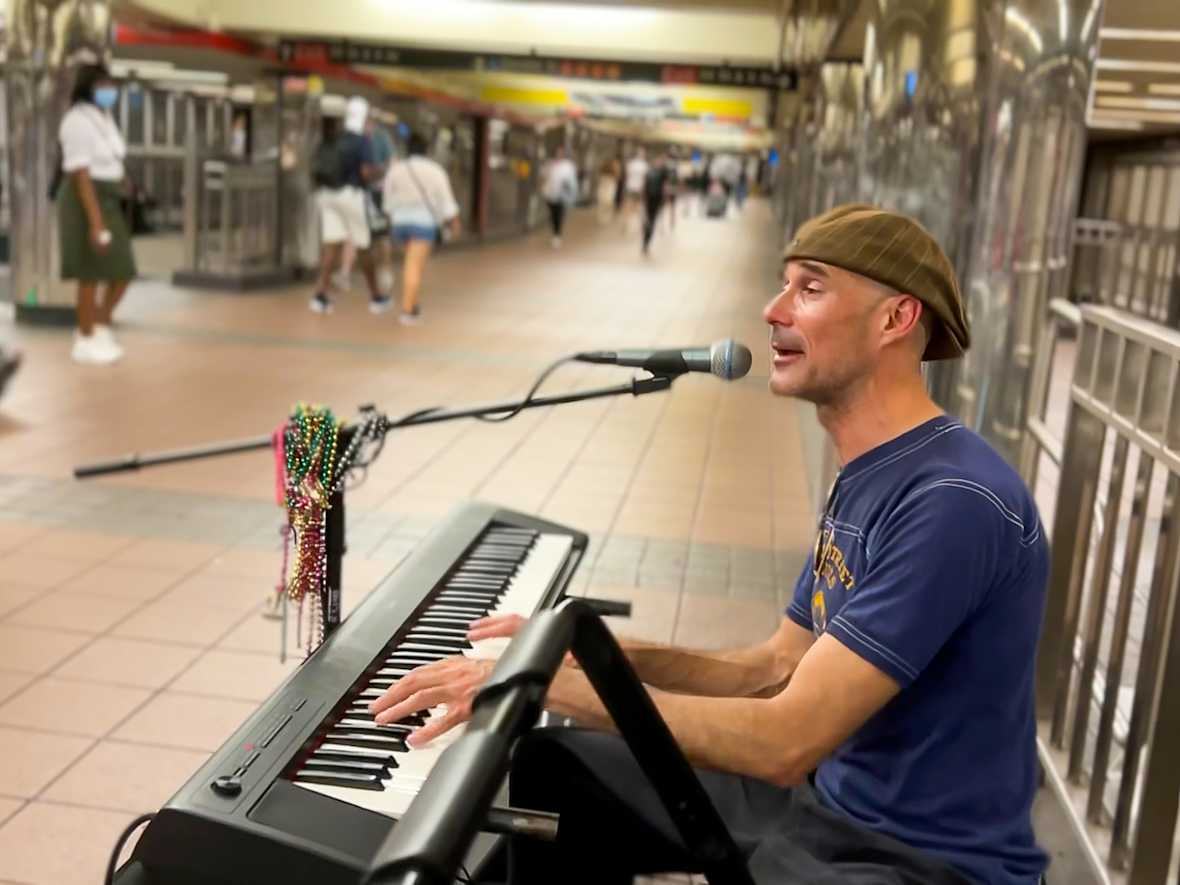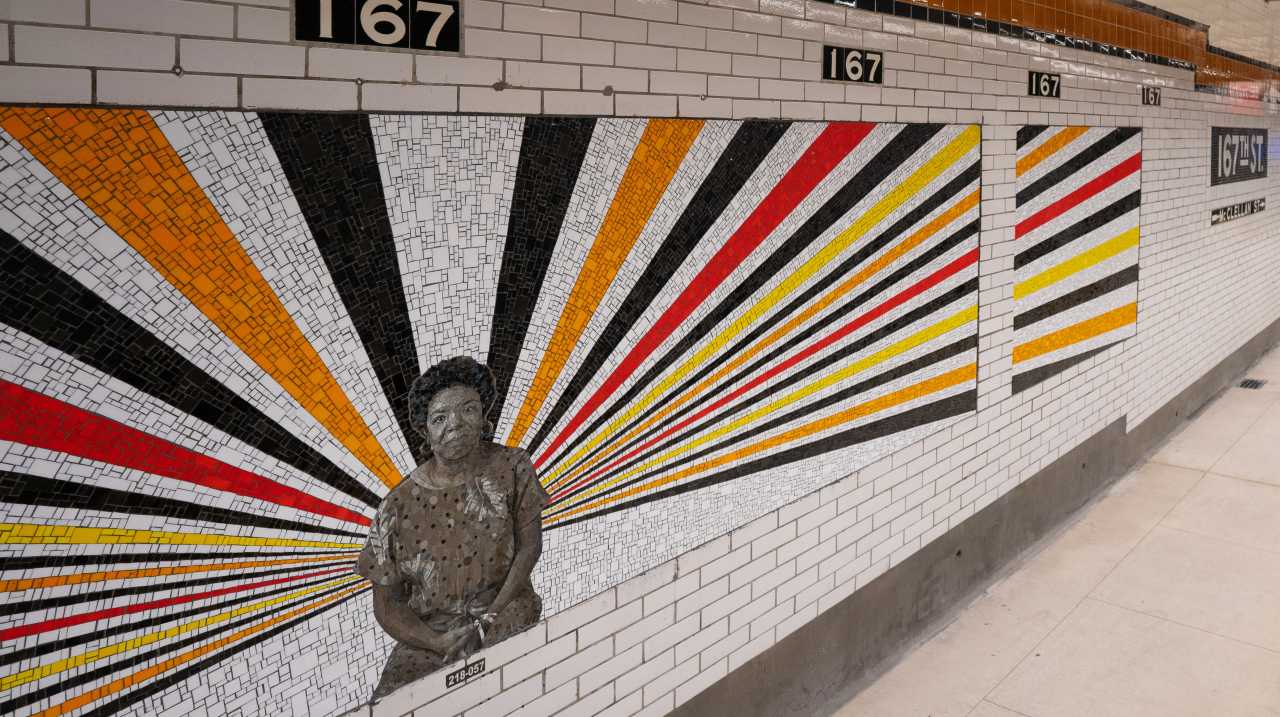Busking has a long tradition inside of the city’s transit system, with performers providing much-needed moments of joy to straphangers.
“Music and art, man. It makes the commute just that much more pleasurable,” says Gabriel Aldort, a pianist who plays in the subway system.
Since 1987, MTA’s Arts & Design Music Under New York program has presented accomplished, first-rate musical artists to perform in and around the transit system, with the goal of delighting commuters and tourists alike. Aldort is one of hundreds of talented musicians on the official MTA roster. While anyone has the legal right to perform in the subway stations, these performers auditioned before a panel of judges to be awarded with thirty prominent locations across the city. For many, the program is not only a venue to practice their craft in front of a live audience—and make some tips in the process—it’s an opportunity to put a smile on faces.
The Big Easy in the Big Apple
Inspired by the music of New Orleans, Gabriel Aldort goes by the spiced up stage name of Galdort Gumbo. “I’m not just a dude who plays piano,” Aldort says. “I’m really steeped in New Orleans blues. My dad turned me on to New Orleans blues. And when I was like seventeen, dude, it just stuck to my ribs.”
Jazzy and bluesy piano covers, in addition to some original songs, are all in Aldort’s repertoire as he tickles the ivories of his Yamaha electric keyboard for his favorite commuter crowd: the morning rush hour and beyond, typically from 8:30 a.m. to noon, in transit hubs like 34th St-Herald Square.
“You go out there and have a beautiful day, y’all,” he says on the microphone in between verses of Leonard Cohen’s "Hallelujah.” “Go out and do a kindness for someone, will ya?”
He jumps from the somber to Dixieland jazz, altering his voice to channel Satchmo, followed by his renditions of Frank Sinatra standards. His talents garner the attention of many who stop to watch him perform a song and drop in the occasional tip. “The best nation is a donation,” he jokes on the mic.
Despite his extroverted nature and comfort of playing to a crowd, it wasn’t his initial intention to play the subway until friends egged him on to audition for the MTA roster. It was around that time in his life when he’d committed to focus on music. “I wasn’t a prolific musician. You know, I’ve been an illustrator, I’ve been a magician. I’ve been a frickin’ babysitter, a valet—every aspect of the service industry. I turned 40—that was a big year—and I chose music as a career.”
Nowadays, he performs gigs in clubs and piano bars, in addition to working with Yamaha. However, he’ll always have a soft spot for uplifting morning commuters, which he finds somewhat therapeutic.
“When I'm out here, even if I'm tired and hungover and I'm just not in a good place in my head, it only takes a couple songs to reset. And I remember why I'm still doing it. Because it's about expressing myself through the language of music. It's about making connections,” he says. “I’m a sucker for acts of kindness—and, yeah, sometimes it's hard to make it through a song. I get choked up just thinking about when people stop by your rendition of something.”
From Solo to Sextet
Upstairs from Herald Square and a few blocks up Broadway in the Garment District, bassist Robert Anderson and his five musical cohorts play a rendition of Charlie Parker’s “Moose the Mooche” for a lunchtime crowd on a sunny day—a change of pace since they’re usually underneath Times Square or Grand Central. As the frontman of the jazz band that bears his name, Anderson has been playing in the transit system since before the Music Under New York program began, and was tapped by the MTA as they developed it.
“I’d do this without them,” Anderson says, “You know I have the banner over there, but I’d do this without that.”
Anderson’s passion for music started when he was twelve years old, playing his first gig as a bongo player at the old Sagamore Club on Dean Street in Brooklyn. From there, his musical career expanded as he started playing acoustic bass at gigs around the country. He was the first bass player for the acclaimed old-time string group, The Ebony Hillbillies. In the ’90s, he was the bassist for a Billboard-charting R&B group Solo. He’s played all across the industry, lugging around his big, upright bass, as he met lots of industry heads, from producers to headliners.
“Michael Jackson even asked me, ‘You carry that thing everywhere you go?’ and I said, ‘Yeah, I carry this everywhere I go.’”
These days, it’s easier to carry an electric bass guitar to a venue, especially down in the subway. But regardless of instrument size, his bass riffs jive with the other musicians that he can gather for a jam session, whether it be a trio, quartet, or sextet, along with his wife, Cheryl Martin on keys. For him, it’s important to bring jazz to the public, so he might influence a younger generation to get into it as he did.
“I do this for the children because kids coming through there, they hear us playing, and tell mommy, ‘Stop mommy, stop.’ They want to stop and hear us play,” he says. “It's a beautiful thing I think for them because there'll be no other way they could hear it. They couldn’t hear jazz music—authentic jazz—without going to a club, sit down, pay twenty-five dollars, or fifty dollars for drinks, or something like that. You just can't hear it anymore. It's gone.”
Street Soul
Azusa Dance goes by the stage name SHESHE, a nickname her kids gave her before she took her musical roots from Tennessee to the big city.
Inspired by the godmothers of soul—Mahalia Jackson, Aretha Franklin, and Big Mama Thornton to name a few—SHESHE began singing her heart out as the lead singer and president of the choir of the Allen Temple African Methodist Episcopal Church in Chattanooga. “I’m a Southern Christian girl,” SHESHE says. “You’re surrounded by music your entire life.”
And when her kids got into musical theater, so did she—"I was like, I really need to do this. That's how I got started." So in addition to sharing her extreme talent with commuters, she also performs beyond the city’s subway system through various theater projects.
SHESHE earned a spot on the MTA roster in 2016 with a powerful audition.
On occasion, she’ll take her act to the streets, and you can find her by the lighthouse at South Street Seaport in Lower Manhattan. Her voice is as grand as her presence: ”big, blonde, and beautiful” as her promotional poster says—an homage to the song in Hairspray.
She draws an audience of passers-by as she belts out her rendition of Etta James’ immortal “At Last.” People start dancing in the plaza—and even across the street—as she grooves to her own soulful version of Aretha’s “Chain of Fools.” Her love of music is as evident as it is infectious.
“The whole point of Music Under New York is to give people some entertainment and to kind of calm their nerves while they're waiting on a train, or whatever is happening. And it really does work—but it's therapy for me as well,” she says. “It makes my heart feel good. And my job, I always feel, whenever I do anything is, if I’m having a blast, I need everybody else to have a blast. And that's my whole goal. If you're having as much fun as I am, then I've succeeded.”
Rails to Radio City
The thunder of after-work rush hour is drowned by the sonic vibrations of a melodic, electric cello bouncing off the walls of the subway mezzanine level underneath Grand Central Terminal. It’s a cover of Ellie Goulding’s “Love Me Like You Do,” performed by Iain Forrest, who goes by the stage name Eyeglasses—even though he doesn’t wear a pair while performing.
“People were asking me, why don’t you change your name to Contact Lenses, because I wear contacts,” he jokes. But the reason behind his stage name is twofold: He’s a medical PhD student studying ophthalmology at Mt. Sinai, and “Eyeglasses” is actually the name of a famous Beethoven composition for a duo of viola and cello—the latter of which became Forrest’s instrument of choice since he was a child.
“As soon as I started playing the first notes on the cello,” he recalled, “it had really rich sounds and low bass notes and everything, and I just fell in love with that sound.”
Forrest moved to New York from Bethesda, Maryland in 2018 and was immediately intrigued by musicians performing on subway platforms—so much that he auditioned himself and made it onto the MTA roster. At 6’ 3”, he has quite a physical presence, but it’s his energetic performances, playing along with his own riffs via looper pedal, that grab the attention of wandering straphangers—including Grammy-nominated Josh Groban.
“Josh Groban, he actually takes the 1/2/3 train. He commutes through there, he saw me, grabbed my stuff, and called me and said, ‘I need you to be at Radio City Music Hall at the end of the month,’” he reminisced. “Dream come true. What are the chances of that?”
After performing at that sold-out Radio City show, Eyeglasses became an item on the news cycle, which led to bigger gigs. Now, he performs at ticketed shows as a soloist at prominent New York venues. However, he still plays for the patients at Mt. Sinai to lift their spirits, and in the tunnels of the subway system where it all began.
“I always think this program is so under-appreciated, but also just not known, really,” he says. “It’s just a wonderful community to be a part of.”
A Night at the Underground Opera

It’s Friday night underneath Union Square, and New Yorkers are ready for the weekend to begin. However, it’s almost impossible not to stop and be moved by the soul-penetrating reverberation of the powerful human voice coming from opera tenor José Heredia, belting out Puccini’s famed aria "Nessun Dorma,” accompanied by soprano Rachel Hippert. They follow up with the recognizable duet “La Brindisi,” the drinking song from Verdi’s La Traviata, along with other opera songs comprising this full-on underground opera concert. A standing ovation ensued, with cries of “Bravo!” coming from one spectator.
Heredia and Hippert are chief members of The Opera Collective, known as “the people’s opera,” who have made the genre more accessible to the public since 2005. While their talents are unmistakably worthy of MTA’s official busker roster, they were grandfathered in with the now 21-person collective, even before they took the reins over from the group’s previous leadership in 2015. Not only have they sung together since then, they began dating after performing a Valentine’s Day concert—and eventually got married in early 2022.
“We were cast to sing an incredible duet from a French opera called Manon by Jules Massenet, and it’s so romantic,” Hippert says, reminiscing with a smirk. “The music is just opulent, gorgeous, and I mean, the right conditions under which to fall in love.”
Hippert was influenced by her parents’ taste in Broadway showtunes, and eventually studied at the Boston University School of Music. Meanwhile, Heredia was inspired by his father, a singer in a meringue band in his birthplace of the Dominican Republic, plus an old cartoon that ultimately inspired him to take voice lessons and attend the Manhattan School of Music.
“I was watching a Disney cartoon of a whale that was an opera singer, and that cartoon was voiced by Nelson Eddy, and I just fell in love with the voice,” Heredia says. “[It was] something that I've never heard before—something that I've never felt before. And since, from that moment on, I kind of just fell in love with it.”
Their individual paths eventually crossed at The Opera Collective, the perfect community to hone their craft. “You learn the most by doing,” Hippert says. “[The Collective is] a safe place to try out new reps, stay on our toes vocally, and make music together. But also do circuits and give music to your community.”
Giving to the community is something Heredia, Hippert, and the other talented performers of The Opera Collective do each time they sing in and around the transit system—sometimes in unexpected heroic ways.
“We had this one instance where this young lady was going through a lot,” reports Heredia. “She just stopped in her tracks and stayed there for the entire duration of the performance, [then] put a note in our little bucket saying ‘I can’t give you any money, but the beauty of the music tonight made me stop and not end my life.'"
“That’s the power of music in the works," Hippert says. "It’s very healing.”
Do you have a favorite subway performer? Share a video or photo on social media and tag us (@MTAaway).



